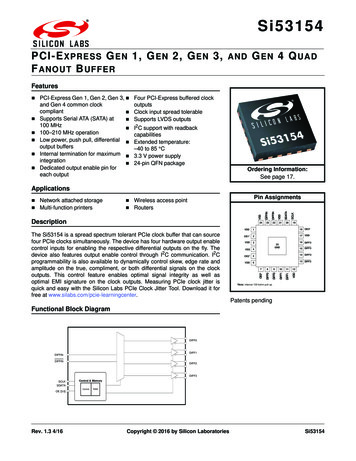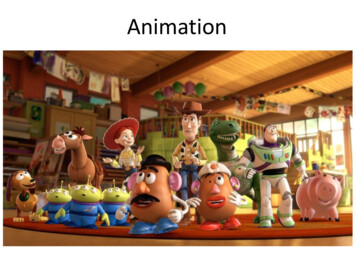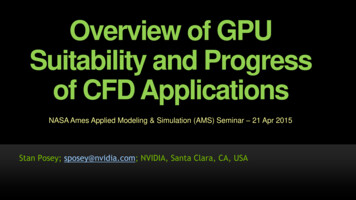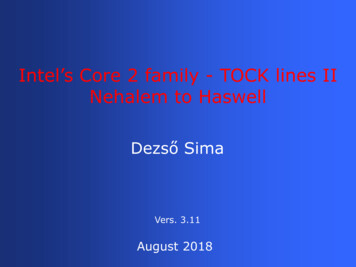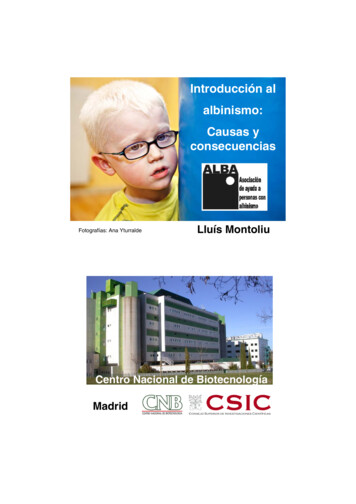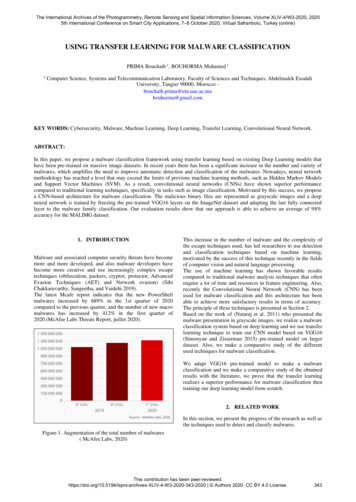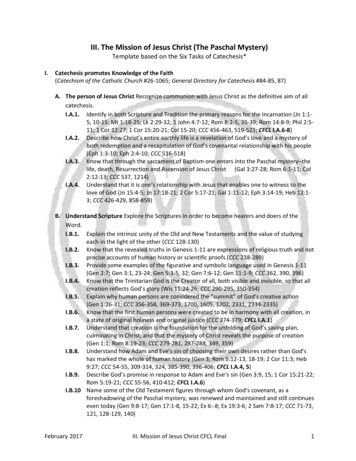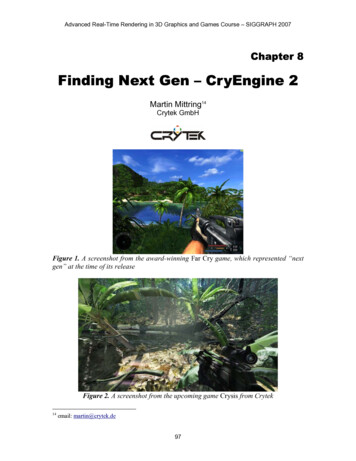
Transcription
Advanced Real-Time Rendering in 3D Graphics and Games Course – SIGGRAPH 2007Chapter 8Finding Next Gen – CryEngine 2Martin Mittring14Crytek GmbHFigure 1. A screenshot from the award-winning Far Cry game, which represented “nextgen” at the time of its releaseFigure 2. A screenshot from the upcoming game Crysis from Crytek14email: martin@crytek.de97
Chapter 8: Finding Next Gen – CryEngine 28.1AbstractIn this chapter we do not present one specific algorithm; instead we try to describe theapproaches the German company named Crytek took to find certain renderingalgorithms that work well together. We believe this information is valuable for anyonethat wants to implement similar rendering algorithms because often the implementationchallenges arise when combining with other algorithms. We will also describe briefly thepath to it as that covers alternative approaches you also might want to consider. This isnot a complete description of everything that was done on the rendering side becausefor this chapter we picked certain areas that are of interest specifically for this audienceand limited ourselves to a presentable extend.The work presented here takes significant advantage of research done by the graphicscommunity in recent years and combines it with novel ideas developed within Crytek torealize implementations that efficiently map onto graphics hardware.8.2IntroductionCrytek Studios developed a technically outstanding Far Cry first person shooter gameand it was an instant success upon its release. Far Cry raised the bar for all games of itsgenre. After our company shipped Far Cry1, one convenient possibility was to develop asequel using the existing engine with little modifications - more or less the same enginewe used for Far Cry. While this could have been an easy and lucrative decision, webelieved that it would prove to be limiting for our goals – technically and artistically. Wemade the decision that we want to develop a new next-generation engine and improvethe design and architecture, along with adding many new features. The new game,named Crysis2, would follow Far Cry with the same genre, but would tremendouslyincrease in scope – everything had to be bigger and better. The new engine, theCryEngine 2, would make that possible.After reading the design document and an intense deliberation session amongst alldesigners, programmers and artists, we arrived at a set of goals for the new engine tosolve:12Shipped March 2003, Publisher: Ubisoft, Platform: PCNot released yet, Publisher: Electronic Arts, Platform: PC98
Advanced Real-Time Rendering in 3D Graphics and Games Course – SIGGRAPH 2007The game would contain three different environmentsMany objects, height map, ocean, bigview distance, ambient lighting with onemain directional light sourceFigure 3. Jungle paradiseMany point lights, dark, huge room likesections, geometry occlusion, fogvolumesFigure 4. Alien indoorenvironmentIce Material layer, subsurface scatteringFigure 5. Ice environmentAchieving all three environments is a challenge as it’s hard to optimize for levels withcompletely different characteristics.Cinematographic quality rendering without hitting the Uncanny ValleyThe closer you get to movies quality, the less forgiving the audience will be.Dynamic light and shadowsPre-computing lighting is crucial to many algorithms that improve performanceand quality. Having dynamic light and shadows prevents us from using most ofthose algorithms because they often rely on static properties.Support for multiple GPU and multiple CPU (MGPU & MCPU)Development with multithreading and multiple graphic cards is much morecomplex and often it’s hard to not scarify other configurations.99
Chapter 8: Finding Next Gen – CryEngine 2Game design requested a 21km 21km game play areaWe considered doing this; but production, streaming, world persistence wouldnot be worth the effort. We ended up having multiple levels with up to 4km 4km.Target GPU from shader model 2.0 to 4.0 (DirectX10)Starting with Shader Model 2.0 was quite convenient but DirectX10 development with early hardware and early drivers often slowed us down.High Dynamic RangeWe had good results with HDR in Far Cry, and for the realistic look we wanted todevelop the game without the LDR limitations.Dynamic environment (breakable)This turned out to be one of the coolest features but it wasn’t easy to achieve.Developing game and engine togetherThat forced us to have the code always in some usable state. That’s simple for asmall project but becomes a challenge when doing on a large scale.Our concept artists created many concept images in order to define the game’s initiallook but in order to ultimately define the feel of the game we produced a video. Theexternal company Blur3 studio produced with our input a few concept videos for us andthat helped to come to consent on the look and feel we wanted to achieve.Figure 6. A frame from one of the concept videos from Blur (rendered off-line) forCrysis.8.3OverviewIn the remainder of this chapter we will first discuss the shader framework used by thenew CryEngine 2. This area turned out to be a significant challenge for our large scaleproduction. Then we will describe our solutions for direct and indirect lighting (includingsome of our design decisions). We can use specialized algorithms by isolating particular3http://www.blur.com100
Advanced Real-Time Rendering in 3D Graphics and Games Course – SIGGRAPH 2007lighting approach into a contained problem and solving it in the most efficient way. In thatcontext, we approach direct lighting primarily from the point of view of shadowing (sinceshading can be done quite easily with shaders of varied sophistication). Indirect lightingcan be approximated by ambient occlusion, a simple darkening of the ambient shadingcontribution. Finally we cover various algorithms that solve the level of detail problem. Ofcourse this chapter will only cover but a few rendering aspects of our engine and manytopics will be left uncovered – but it should give a good “taste” of the complexity of oursystem and allow us to dig in into a few select areas in sufficient details.8.4Shaders and Shading8.4.1 Historical Perspective on CryEngine 1In Far Cry we supported graphics hardware down to NVIDIA GeForce 2 which meanswe not only had pixel and vertex shader but also fixed function transform and lighting(T&L) and register combiner (pre pixel shader solution to blend textures) support.Because of that and to support complex materials for DirectX and OpenGL our shaderscripts had complex syntax.After Far Cry we wanted to improve that and refactored the system. We removed fixedfunction support and made the syntax more FX-like as described in [Microsoft07].Very late in the project our renderer programmer introduced a new render path that wasbased on some über-shader approach. That was basically one pixel shader and vertexshader written in CG/HLSL with a lot of #ifdef. That turned out to be much simpler andfaster for development as we completely avoided the hand optimization step. The earlyshader compilers were not always able to create shaders as optimal as humans coulddo but it was a good solution for shader model 2.0 graphics cards.The über-shader had so many variations that compiling all of them was simply notpossible. We accepted a noticeable stall due to compilation during development (whenshader compilation was necessary) but we wanted to ship the game with a shader cachethat had all shaders precompiled. We ended up playing the game on NVIDIA and on ATItill the cache wasn’t getting new entries. We shipped Far Cry with that but clearly thatwasn’t a good solution and we had to improve that. We describe a lot more details aboutour first engine in [Wenzel05].8.4.2 CryEngine 2We decided to reduce a number of requirements for cleaner engine. As a result weremoved support for OpenGL and fixed function pipeline support. This allowed us tomake the shader scripts more FX format compatible. Then developing shaders becamemuch more convenient and simple to learn.101
Chapter 8: Finding Next Gen – CryEngine 2We still had the problem with too many shader combinations and wanted to solve that.We changed the system by creating a shader cache request list. That list was gatheredfrom all computers in the company over the network and it was used during the nightlyshader cache compilation. However compilation time was long so we constantly had toreduce the amount of combinations.We had the following options:Dynamic branchingReducing combinations and accepting less functionalityReducing combinations and accepting less performanceSeparating into multiple passesWe did that in multiple iterations and together with a distributed shader compilation wemanaged to compile all shaders for a build in about an hour.8.4.3 3DcTM for Normal MapsThe 3DcTM texture format introduced by ATI [ATI04] allows compressing normal maps inone byte per texel with good quality and only little extra shader cost (reconstructing the zcomponent). Uncompressed normal maps cost 4 bytes per texel (XYZ stored in RGB,one byte usually wasted for padding). In our new engine we decided to not do texturecompression at load time. Textures become processed by our resource compiler tooland there we generate the mip levels and apply the compression. This way we getsmaller builds and faster loading. For hardware that doesn’t allow 3DcTM compressionwe convert the 3DcTM to DXT5 at load time. The formats are quite similar and conversionis simple. The minor quality loss is acceptable for low spec. Older NVIDIA cards have3DcTM emulation in the drivers so we don’t have to take care of that (appears withoutvisible quality loss, however, with this solution requires 2 byte per texel storage).8.4.4 Per-Pixel Scene DepthUsing an early z pass can reduce per pixel shading cost because many pixel can berejected based on the z value before a pixel shader needs to be executed. Frombeginning on we based our rendering on early z because we expected heavy pixelshader usage. For that we have to accept a higher draw call count. For many effects thedepth value would be useful. As it wasn’t possible to bind the z buffer we decided tooutput that value to a texture. At first we used the R16G16 texture format as this wasavailable on all hardware and the 16 bit float quality was sufficient. Initially we had someuse for the second channel but later we optimized that away. On ATI R16 was an optionand to save some memory and bandwidth we used that format. We realized on somehardware the R16G16 is actually slower than the R32 format so we used R32 when R16was not available. An even better option is using the z buffer directly as we don’t need102
Advanced Real-Time Rendering in 3D Graphics and Games Course – SIGGRAPH 2007extra memory and the early z pass can run faster (double speed without color write onsome hardware). So we ended up using R16, R32 or even native z buffer – dependingon what is available.The depth value allows some tricks known from deferred shading. With one MADoperation and a 3 component interpolator it’s possible to reconstruct the world spaceposition. However for floating point precision it’s better to reconstruct positions relative tothe camera position or some point near to it. That is especially important when using24bit or 16bit float in the pixel shader. By offsetting all objects and lights it’s possiblemove the 0, 0, 0 origin near the viewer. Without doing this decals and animations canflicker and jump. We used the scene depth for per pixel atmospheric effects like theglobal fog, fog volumes and soft z buffered particles.Shadow mask generation uses scene depth to reduce draw call count. For the water weuse the depth value to soft clip the water and fade in a procedural shore effect. Severalpost processing effects like motion blur, Depth of Field and Edge blurring (EdgeAA)make use of the per pixel depth as well. We describe these effects in detail in[Wenzel07].8.4.5 World Space ShadingIn Far Cry we transformed the view and the light positions into tangent space (relative tothe surface orientation). All data in the pixel shader was in tangent space so shadingcomputations were done in that space. With multiple lights we were running intoproblems passing the light parameters over the limited amount of interpolators. Toovercome this problem we switched to use world-space shading for all computations inCrisis (in actuality we use world-space shading with an offset in order to reduce floatingpoint precision issues). The method was already needed for cube map reflections socode became more unified and shading quality improved as this space is not distortedas tangent space can be.Parameters like light position now can be passed in pixel shader constants and don’tneed to be updated for each object. However when using only one light and simpleshading the extra pixel cost is higher.8.5Shadows and Ambient Occlusion8.5.1 Shadowing Approach in CryEngine 1In our first title Far Cry we had shadow maps and projected shadows per object for thesun shadows. We suffered from typical shadow map aliasing quality issues but it was agood choice at that time. For performance reasons we pre-computed vegetationshadows but memory restrictions limited us to very blurry textures. For high end103
Chapter 8: Finding Next Gen – CryEngine 2hardware configurations we added shadow maps even to vegetation but combining themwith the pre-computed solution was flawed.We used stencil shadows for point lights as that were an easier and more efficientsolution. CPU skinning allowed shadow silhouette extraction on the CPU and the GPUrendered the stencil shadows. It became obvious that this technique would become aproblem the more detailed objects we wanted to render. It relied on CPU skinning,required extra CPU computation, an upload to GPU, extra memory for the edge datastructures and had hardly predictable performance characteristics. The missing supportfor alpha-blended or tested shadow casters made this technique not even usable for thepalm trees – an asset that was crucial for the tropical island look (Figure 7).Figure 7. Far Cry screenshot: note how the soft precomputed shadows combine with thereal-time shadowsFor some time during development we had hoped the stencil shadows could be used forall indoor shadows. However the hard stencil shadows look and performance issues withmany lights made us search for other solutions as well.One of such solutions is to rely on light maps for shadowing. Light maps have the sameperformance no matter how many lights and allow a soft penumbra. Unfortunately whatis usually stored is the result of the shading, a simple RGB color. That doesn’t allownormal mapping. We managed to solve this problem and named our solutionDot3Lightmaps [Mittring04]. In this approach the light map stores an average lightdirection in tangent space together with an average light color and a blend value to lerpbetween pure ambient and pure directional lighting. That allowed us to render the diffusecontribution of static lights with soft shadows quite efficiently. However it was hard tocombine with real-time shadows. After Far Cry we experimented with a simplemodification that we named Occlusion maps. The main concept is to store the shadowmask value, a scalar value from 0 to 1 that represents the percentage of geometryocclusion for a texel. We stored the shadow mask of multiple lights in the light maptexture and the usual four texture channels allowed four lights per texel. This way werendered diffuse and specular contributions of static lights with high quality soft shadowswhile the light color and strength remained adjustable. We kept lights separate socombining with other shadow types was possible.104
Advanced Real-Time Rendering in 3D Graphics and Games Course – SIGGRAPH 20078.5.2 The Plan for CryEngine 2The time seemed right for a clean unified shadow system. Because of the problemsmentioned we decided to drop stencil shadows. Shadow maps offer high quality softshadows and can be adjusted for better performance or quality so that was our choice.However that only covers the direct lighting and without the indirect lighting componentthe image would not get the cinematographic realistic look we wanted to achieve. Theplan was to have a specialized solution for the direct and another one for the indirectlighting component.8.5.3 Direct LightingFor direct lighting we decided to apply shadow maps (storing depth of objects seen fromthe light in a 2D texture) only and drop all stencil shadow code.8.5.3.1Dynamic Occlusion MapsTo efficiently handle static lighting situations we wanted to do something new. By usingsome kind of unique unwrapping of the indoor geometry the shadow map lookup resultscould be stored into an occlusion map and dynamically updated. The dynamic occlusionmap idea was good and it worked but shadows often showed aliasing as now we notonly had shadow map aliasing but also unwrapping aliasing. Stretched texturesintroduced more artifacts and it was hard to get rid of all the seams. Additionally we stillrequired shadow maps for dynamic objects so we decided to get the maximum out ofnormal shadow maps and dropped the caching in occlusions maps.8.5.3.2Shadow Maps with Screen-Space Randomized Look-upPlain shadow mapping suffers from aliasing and has hard jagged edges (see first imagein Figure ). The PCF extension (percentage closer filtering) limits the problem (secondimage in Figure ) but it requires many samples. Additionally at the time hardware supportwas only available on NVIDIA graphics cards such as GeForce 6 and 7 generation andemulation was even slower. We could implement the same approach on newer ATIgraphics cards by using Fetch4 functionality (as described in [Isidoro06]).Instead of adding more samples to the PCF filter we had the idea to randomize thelookup per pixel so that less samples result in similar quality accepting a bit of imagenoise. Noise (or grain) is part of any film image and the sample count offers an idealproperty to adjust between quality and performance. The idea was inspired by softshadow algorithms for ray tracing and already applied to shadow maps on GPU (See[Uralsky05] and [Isidoro06] for many details with regards to shadow map qualityimprovement and optimization).105
Chapter 8: Finding Next Gen – CryEngine 2The randomized offsets that form a disk shape can be applied in 2D when doing thetexture lookup. When using big offsets the quality for flat surfaces can be improved byorienting the disk shape to the surface. Using a 3D shape like a sphere can have highershading cost but it might soften bias problems.To get acceptable results without too much noise multiple samples are needed. Thesample count and the randomization algorithm can be chosen depending on quality andperformance needs. We tried two main approaches: randomly rotated static kernel[Isidoro06] and another technique that allowed a simpler pixel shader.Figure 8. Example of shadow mapping with varied resulting quality: from left to right:no PCF, PCF, 8 samples, 8 samples blur, PCF 8 samples, PCF 8 samples blurThe first technique requires a static table of random 2D points and a texture with randomrotation matrices. Luckily the rotation matrixes are small (2 2) and can be efficientlystored in a 4 component texture. As the matrices are orthogonal further compression ispossible but not required. Negative numbers can be represented by the usual “scale andbias” trick (multiply the value by 2 and subtract 1) or by using floating point textures. Wetried different sample tables and in the Figure 8 you can see an example of applying thisapproach to a soft disc that works quite well. For a disc shaped caster you would expecta filled disk but we haven’t added the inner samples as the random rotation of those areless useful for sampling. The effect is rarely visible but to get more correct results we stillconsider changing it.The simpler technique finds its sample positions by transforming one or two randompositive 2D positions from the texture with simple transformations. The first point can beplaced in the middle (mx, my) and four other points can be placed around using therandom value (x, y).(mx,(mx x,(mx-y,(mx-x,(mx y,my)my y)my x)my-y)my-x)More points can be constructed accordingly but we found it only useful for materialsrendered on low end hardware configurations (where we would want to keep the samplecount low for performance reasons).106
Advanced Real-Time Rendering in 3D Graphics and Games Course – SIGGRAPH 2007Both techniques also allow adjusting the kernel size to simulate soft shadows. To getproper results this kernel adjustment would be dependent on the caster distance and thelight radius but often this can be approximated much easier. Initially we randomized byusing a 64x64 texture tiled with a 1:1 pixel mapping over the screen (Figure 9)Figure 9. An example of the randomized kernel adjustment textureThis texture (Figure 9) was carefully crafted to appear random without recognizablefeatures and with most details in the higher frequencies. Creating a random texture isfairly straight-forward; we can manually reject textures with recognizable features andwe can maximize higher frequencies applying a simple algorithm that finds a good pairof neighbor pixels that can be swapped. A good swapping pair will increase highfrequencies (computed by summing up the differences). While there are certainly bettermethods to create a random texture with high frequencies), we only describe but thissimple technique as it served our purposes.Film grain effect is not a static effect so we could potentially animate the noise andexpect it to hide low sample count even more. Unfortunately the result was perceived asa new type of artifact with low or varying frame rate. Noise without animation lookedpleasing for static scenes; however with a moving camera some recognizable staticfeatures in the random noise remained on the screen.8.5.3.3Shadow Maps with Light-Space Randomized Look-upFortunately we found a good solution for that problem. Instead of projecting the noise tothe screen we projected a mip-mapped noise texture in world space in the light/sundirection. In medium and far distance the result was the same but because of bilinearmagnification the nearby shadow edges became distorted and no longer noisy. Thatlooked significantly better – particularly for foliage and vegetation, where the exactshadow shape was hard to determine.8.5.3.4Shadow Mask TextureWe separated the shadow lookup from shading in our shaders in order to avoid theinstruction count limitations of Shader Model 2.0, as well as to reduce the number ofresulting shader combinations and be able to combine multiple shadows. We stored the8 bit result of the shadow map lookup in a screen-space texture we named shadow107
Chapter 8: Finding Next Gen – CryEngine 2mask. The 4 channel 32 bit texture format offers the required bit count and it can beused as a render target. As we have 4 channels we can combine up to 4 lightcontributions in a texel.Figure 10. Example of shadow maps with randomized look-up. Left top row image: nojittering 1 sample, right top row image: screen space noise 8 samples, left bottom: worldspace noise 8 samples, right bottom: world space noise with tweaked settings 8 samples108
Advanced Real-Time Rendering in 3D Graphics and Games Course – SIGGRAPH 2007Figure 11. Example of the shadow mask texture for a given scene: Left: final renderingwith sun (as a shadow caster) and two shadow-casting lights, right: light mask texturewith three lights in the RGB channelsFigure 12. Example of the shadow mask texture for a given scene - Red, Green and Bluechannel store the shadow mask for 3 individual lightsIn the shading pass we bind this texture and render multiple lights and the ambient atonce. We could have used the alpha channel of the frame buffer but then we would havemore passes and draw call count would raise a lot. For opaque objects and alpha testsurfaces the shadow mask is a good solution but it doesn’t work very well for alphablended geometry. All opaque geometry is represented in the depth buffer but alphablended geometry is not modifying the depth buffer. Transparent geometry requiresnormal shadow map lookup in the shader.8.5.3.5Shadow Maps for Directional Light SourcesIn Far Cry we had only a few shadow casting objects and each had its own shadowmap. For many objects its better to combine them on one shadow map. A simple parallelprojection in the direction of the light works but near the viewer the shadow mapresolution is quite low and then shadows appear blocky. Changing the parameterizationlike finding a projection matrix that moved more resolution near the viewer is possiblebut not without problems. We tried trapezoidal shadow maps ([MT04]) (TSM) andperspective shadow maps ([SD02]) (PSM).We had more success with cascaded shadow maps (CSM) where multiple shadowmaps of the same resolution cover the viewer area with multiple projections. Eachprojection is enclosed by the previous one with decreasing world to texel ratio. Thattechnique was giving satisfactory results but wasted some texture space. That wasbecause the projection only roughly concentrated to the area in front of the viewer. Tofind proper projection the view frustum (reduced by the shadow receiving distance) can109
Chapter 8: Finding Next Gen – CryEngine 2be sliced up. Each shadow map needs to covers one slice. Slices farther away cancover bigger world space areas. If the shadow map projection covers the slices tightlythen minimal shadow map area is wasted.With earlier shadow techniques we already had aliasing of the shadow maps when doingcamera movements and rotations. For PSM and TSM we haven’t been able to solve theissue but for CSM and its modification it was possible. We simply snapped theprojections per shadow map texel and that resulted in a much cleaner look.8.5.3.6Deferred Shadow Mask GenerationThe initial shadow mask generation pass required rendering of all receiving objects andthat resulted in many draw calls. We decoupled shadow mask generation from thereceiver object count by using deferred techniques. We basically render a full screenpass that binds the depth texture we created in the early z pass. Simple pixel shadercomputations give us the shadow map lookup position based on the depth value. Theindirection over the world-space position is not needed.As mentioned before we used multiple shadow maps so the shadow mask generationpixel shader had to identify for each pixel in which shadow map it falls and index into theright texture. Indexing into a texture can be done with DirectX10 texture arrays feature orby offsetting the lookup within a combined texture.By using the stencil buffer we were able to separate processing of the individual slicesand that simplified the pixel shader. Indexing was not needed any more. The modifiedtechnique runs faster as less complex pixel shader computations need to be done. Italso carves away far distant areas that don’t receive shadows.8.5.3.7Unwrapped Shadow Maps for Point LightsThe usual shadow map approach for point light sources require a cube map texturelookup. But then hardware PCF cannot be used and on cube maps there is much lesscontrol for managing the texture memory.We unwrapped the cube map into six shadow maps by separating the six cases with thestencil buffer, similar we did for CSM. This way we transformed the point light sourceproblem to the projector light problem. That unified the code and resulted in less code tomaintain and optimize and less shader combinations.8.5.3.8Variance Shadow MapsFor terrain we initially wanted to pre-compute a texture with start and end angle. We alsotried to update an occlusion map in real-time with incremental updates. However the110
Advanced Real-Time Rendering in 3D Graphics and Games Course – SIGGRAPH 2007problem has always been objects on the terrain. Big objects, partly on different terrainsectors required proper shadows. We tried to use our normal shadow map approach andit gave us a consistent look that wasn’t soft enough. Simply making the randomizedlookup with a bigger radius would be far too noisy. Here we tried variance shadow maps[DL06] and this approach has worked out nicely. The usual drawback of varianceshadow maps arises with multiple shadow casters behind each other but that’s a rarecase with terrain shadows.Figure 13. Example of applying variance shadow maps to a scene. Top image: varianceshadow maps aren’t used (note the hard normal shadows), bottom image: with varianceshadow maps (note how the two shadow types combine)8.5.4 Indirect LightingThe indirect lighting solution can be split in two sub-problems: the processing intensivepart of computing the indirect lighting and the reconstruction of the data in the pixelshader (to support per-pixel lighting).8.5.4.13D Transport SamplerFor the first part we had planned to develop a tool called 3D transport sampler. This toolwould make it possible to compute the global illumination data distributed on multiplemachines (for performance reasons). Photon mapping ([Jensen01]) is one of the mostaccepted methods for global illumination computation. We decided to use this methodbecause it can be easily integrated and delivers good results quickly. The photon111
Chapter 8: Finding Next Gen – CryEngine 2Figure 14. Real-time ambient maps with one light sourcemapper was first used to create a simple light map. The unwrapping technique in our oldlight mapper was simple and only combined triangles that were connected and had asimilar plane equation. That resulted in many small 2D blocks we packed into multipletextures. When used for detailed models it became inefficient in texture usage and itresulted in many small discontinuities on the unwrapping borders. We changed theunwrapping technique so it uses the models UV unwrapping as a base and modifie
Chapter 8: Finding Next Gen - CryEngine 2 100 x Game design requested a 21km 21km game play area We considered doing this; but production, streaming, world persistence would not be worth the effort. We ended up having multiple levels with up to 4km 4km. x Target GPU from shader model 2.0 to 4.0 (DirectX10) Starting with Shader Model 2.0 was quite convenient but DirectX10

